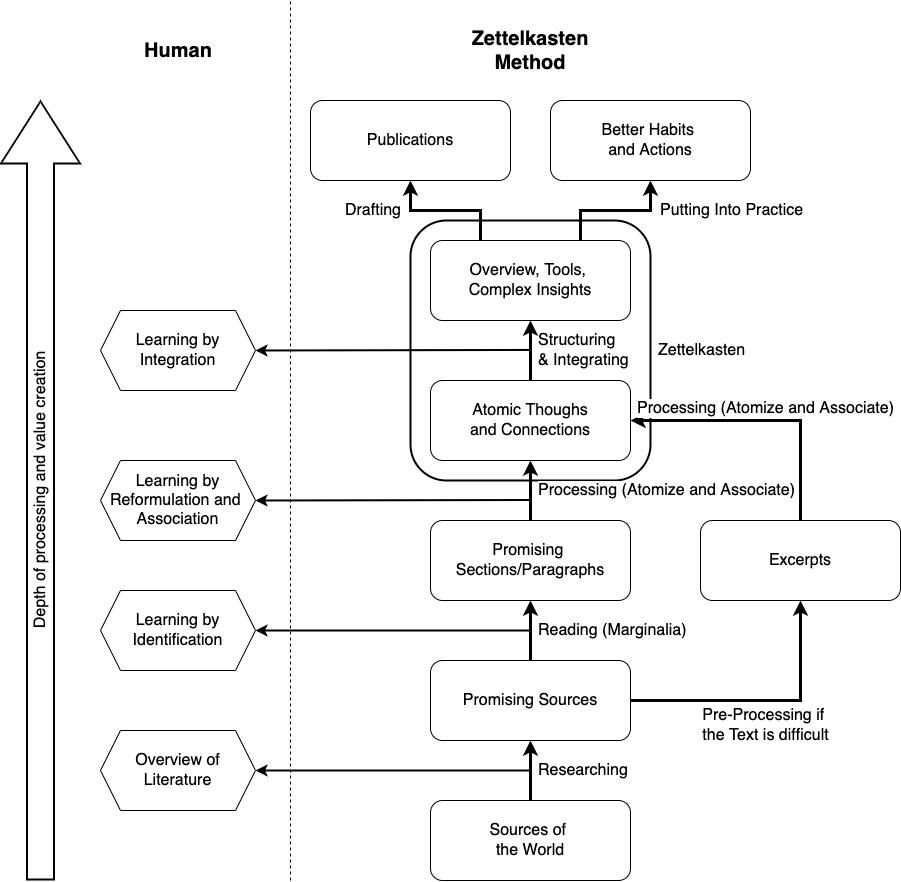Every Step in the Process Must be Knowledge-Based Value Creation
The Zettelkasten Method is so labor-intensive. I don’t have time to also maintain a Zettelkasten.
This, or something like it, is a regular concern when people engage with the Zettelkasten Method. And with good reason, because on the forums and Reddit you can see that care and maintenance seems to be a big part of the Zettelkasten Method.
- Instead of just tagging the notes with keywords and relying on full-text search later, you now have to search the Zettelkasten for opportunities to link to them, and then set link manually.
- You no longer collect citations, but instead have to write everything in your own words.
- You have structure notes, maps of contents, and indexes to maintain.
It seems that Zettelkasten means a lot of additional work. For us busy, constantly stressed modern people, this is understandably off-putting.

Everything Created is Knowledge-Based Value If Done Right
The problem described above is not a problem of the Zettelkasten Method in itself, but a problem of its implementation.
A good implementation of the Zettelkasten Method is lean. This means that you are fully focused on knowledge-based value creation. Your Zettelkasten is created on the side, and then continuously provides more and more added value as it grows. After all, this is the promise of the Zettelkasten Method: You create a thinking machine that multiplies the output of your work.
Let’s transform the three labor intensive steps from above into steps of knowledge-based value creation.
- Linking should be done in such a way that knowledge is created. For this very reason, it is necessary to create a precise link descriptions (I call those “link contexts”). These descriptions themselves are new knowledge and not merely something you do for your Zettelkasten to work properly.
- Writing in your own words must not be paraphrasing in the sense of parroting. It is a matter of really making the thought your own. To ensure this, you should test yourself by interpreting the idea at hand and applying it to something. (This reflects the structural layers of phenomen, interpretation, and synthesis.) This test is also knowledge creation. It is not a step that just serves to maintain the Zettelkasten.
- Incorporating new notes into structure notes is not merely about making the note retrievable. Incorporation of the individual note is about relating it to a higher, more general structure. This improves the utility of the structure note by making it a better entry point, tool box, overview or whatever you are using it for.
These transformations are not merely a play of words. You could link, write in your own words, and maintain indexes as an acts of knowledge management. Then you’ll grow frustrated because you just increased your workload with no actual knowledge-based value creation. So, my advice to you is to be diligent in each action you take. Instead of managing knowledge you’ll create knowledge. This is not only both more efficient and effective. It is also way more rewarding psychologically.
Application
Look at the following diagram:

There is no step in the process that is not adding value in the sense of creating knowledge. That’s by design.
The ratio of (1) work that goes into knowledge-based value creation to (2) work that goes into maintaining the Zettelkasten and its surrounding tools is one of my metrics to assess the quality of an implementation of the Method.

So my advice to you is:
Review your work steps and ask yourself the following question: whatever you do to maintain your notes, can you do it in a way that leads to direct knowledge-based value creation?
Christian’s Comment: I can only barely remember the friction of adopting structure notes more systematically some years ago. Going through the motions when they are not already habitual can be a drudge. But when it clicked, it became a natural process: “Of course I want to take note and give an overview of all I know about X, so I create a structure note for it!” (What else would I do? Obfuscate the trails or make finding things harder? Ha!) Shifting the focus from the note to the idea or the knowledge makes the representation stand out less. I’m thinking: “How can I bring these ideas together?”, not “How can I make this graph of notes more orderly?”